Molti utenti di WordPress preferiscono lavorare sui propri siti web utilizzando un server locale sul proprio computer. In questo modo è possibile lavorare sul sito web in modo privato prima di rendere disponibili le modifiche on line.
Alla fine, dovrete spostarlo su un server live per renderlo accessibile ai visitatori online. Questa transizione è fondamentale per garantire il corretto funzionamento del sito web on line.
Abbiamo lavorato su molti siti web locali, quindi abbiamo dovuto imparare il modo più semplice per trasferire i contenuti a siti web in carne e ossa.
In questo articolo forniremo istruzioni passo passo su come spostare WordPress da un server locale a un sito live.
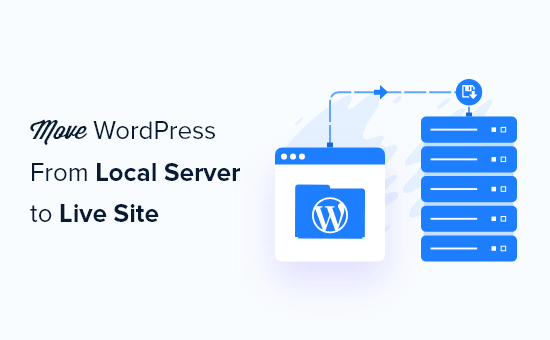
Perché spostare WordPress da un server locale a un sito live?
Creare il vostro blog WordPress su un server locale è un modo sicuro per testare le modifiche apportate al vostro sito web senza influenzare i visitatori.
Una volta perfezionato il sito web, il passo successivo consiste nel passare dal server locale a un sito live.
Vi mostriamo due modi per spostare il vostro sito da un server locale a un sito live.
Il primo metodo utilizza un plugin di migrazione di WordPress ed è consigliato ai principianti.
Nel secondo metodo, vi mostreremo come spostare manualmente WordPress da un server locale a un sito live.
Potete scegliere il metodo più adatto a voi:
Prima di migrare il sito WordPress
Per migrare WordPress da un server locale a un server live è necessario disporre di alcuni elementi.
Innanzitutto, supponiamo che abbiate un sito WordPress in esecuzione su un server locale (chiamato anche localhost) sul vostro computer e che abbiate pieno accesso ad esso.
Successivamente, è necessario disporre di un nome di dominio e di un hosting web.
Abbiamo sentito innumerevoli storie di principianti che hanno iniziato con fornitori di hosting web scadenti o gratuiti e se ne sono pentiti. Secondo la nostra esperienza, la scelta del giusto fornitore di hosting è fondamentale per il successo di qualsiasi sito web.
Per facilitare la vostra decisione, vi consigliamo di utilizzare Bluehost. Si tratta di una società di hosting WordPress ufficialmente raccomandata, che offre agli utenti di WPBeginner uno sconto esclusivo + dominio e SSL gratuiti.
In pratica, potete iniziare a lavorare con soli 1,99 dollari al mese.
Se volete un’ottima alternativa a Bluehost, potete dare un’occhiata a Hostinger. Offre anche uno sconto esclusivo agli utenti di WPBeginner con un nome di dominio gratuito.
Se potete permettervi di pagare un po’ di più, allora date un’occhiata a SiteGround. Hanno anche un’offerta speciale per i lettori di WPBeginner.
Se avete bisogno di aiuto per creare il vostro sito web, seguite la nostra guida passo passo su come creare un sito web.
Infine, è necessario disporre di un programma FTP e sapere come usare l’FTP per caricare il sito del server locale sul sito live.
Siete pronti? Iniziamo la migrazione del vostro sito WordPress.
Video tutorial
Se preferite le istruzioni scritte, continuate a leggere.
Metodo 1: Trasferire WordPress dal server locale al sito live utilizzando un plugin di migrazione (consigliato)
Questo metodo è più semplice e consigliato ai principianti. Utilizzeremo un plugin di migrazione di WordPress per spostare WordPress da localhost a un sito live.
Passo 1: Installare e configurare il plugin Duplicator
Per prima cosa, è necessario installare e attivare il plugin Duplicator sul sito locale. Per maggiori dettagli, consultate la nostra guida passo-passo su come installare un plugin di WordPress.
Suggerimento professionale: Esiste anche una versione pro di Duplicator che offre backup sicuri, archiviazione su cloud, ripristino semplice del sito e altro ancora.
Dopo l’attivazione, è necessario andare alla pagina Duplicator ” Backups e fare clic sul pulsante ‘Create New’.
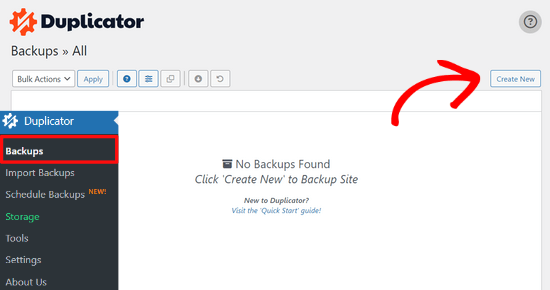
Si accede così a una schermata in cui è possibile assegnare un nome al backup.
Quindi, fare clic sul pulsante “Avanti”.

Duplicator eseguirà ora alcuni test per verificare che tutto sia in ordine.
Se tutti gli elementi sono contrassegnati da “Buono”, cliccate sul pulsante “Costruisci”.

Questo processo può richiedere alcuni minuti, a seconda delle dimensioni del sito web. È necessario lasciare aperta questa scheda fino al completamento.
Una volta terminato, verranno visualizzate le opzioni di download per i pacchetti “Installatore” e “Archivio”. È necessario fare clic sul pulsante “Scarica entrambi i file” per scaricare entrambi i file sul computer.

Il file “Archivio” è una copia completa del vostro sito WordPress. Include tutti i file principali di WordPress, nonché le immagini, i caricamenti, i temi, i plugin e un backup del database di WordPress.
Il file “Installer” è uno script che automatizza l’intero processo di migrazione scompattando il file di archivio contenente il vostro sito web.
Fase 2: Creare un database per il vostro sito web WordPress dal vivo
Prima di eseguire il programma di installazione o di caricare il sito web WordPress da localhost al vostro server di hosting, dovete creare un database MySQL per il vostro nuovo sito web live.
Se avete già creato un database MySQL, potete saltare questo passaggio.
Per creare un database, è necessario visitare la dashboard del cPanel del proprio account di hosting. Quindi, individuate la sezione “Database” e fate clic sull’icona “MySQL Database Wizard”.
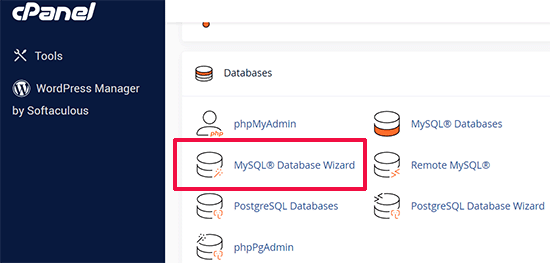
Nella schermata successiva, c’è un campo per creare un nuovo database.
È sufficiente indicare un nome per il database e fare clic sul pulsante “Crea database”.

cPanel creerà ora un nuovo database per voi.
A questo punto, è necessario inserire un nome utente e una password per il nuovo utente e fare clic sul pulsante “Crea utente”.
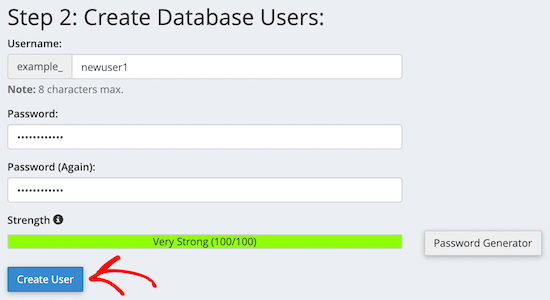
Successivamente, è necessario aggiungere l’utente appena creato al database.
Innanzitutto, fare clic sulla casella di controllo “Tutti i privilegi”.
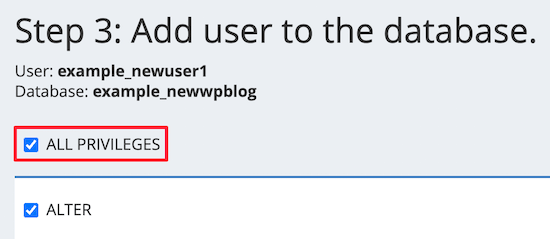
Quindi, scorrere verso il basso e fare clic sul pulsante “Applica modifiche” per salvare le modifiche.
Il database è ora pronto per essere utilizzato con il vostro sito WordPress. Assicuratevi di annotare il nome del database, il nome utente e la password. Queste informazioni vi serviranno nella fase successiva.
Fase 3: caricare i file dal server locale al sito web WordPress dal vivo
Ora è necessario caricare i file dell’archivio e del programma di installazione dal sito locale all’account di hosting.
Per prima cosa, collegatevi al vostro sito live utilizzando un client FTP. Una volta collegati, assicuratevi che la directory principale del vostro sito sia completamente vuota.
Normalmente, la directory principale è la cartella /home/public_html/.
Alcune società di hosting WordPress installano automaticamente WordPress al momento dell’iscrizione. Se sono presenti file di WordPress, è necessario eliminarli.
Successivamente, è possibile caricare i file archive.zip e installer.php da Duplicator nella cartella principale vuota.

Passo 4: esecuzione dello script di migrazione
Dopo aver caricato i file di migrazione, è necessario visitare il seguente URL nel browser:
http://example.com/installer.php
Non dimenticate di sostituire “example.com” con il vostro nome di dominio.
In questo modo si avvia la migrazione guidata di Duplicator.
Il programma di installazione eseguirà alcuni test e inizializzerà lo script.
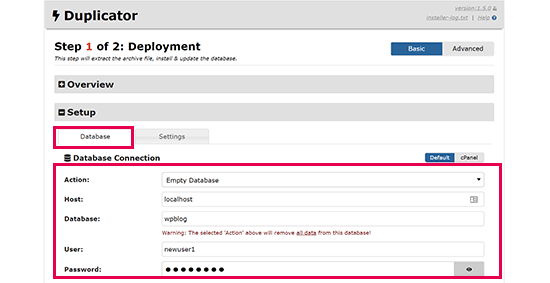
Nella sezione Setup, vi verrà chiesto di inserire l’host MySQL, il nome del database, il nome utente e la password.
L’host sarà probabilmente un host locale. Successivamente, si inseriranno i dettagli del database creato nel passo precedente.
Quindi, fare clic sul pulsante “Convalida” per verificare che i dati inseriti siano corretti.
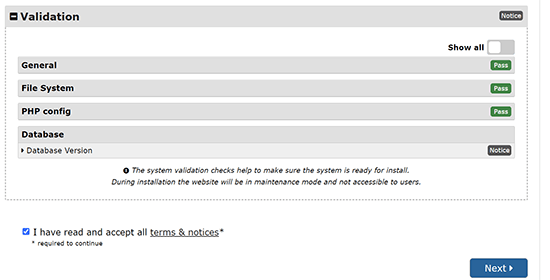
Dopodiché, fare clic sul pulsante “Avanti” per continuare.
Duplicator importerà ora il backup del database di WordPress dall’archivio al nuovo database.
Inoltre, aggiorna gli URL che puntano al sito locale e al nuovo sito live.
A questo punto è possibile fare clic sul pulsante “Admin Login” per accedere all’area di amministrazione di WordPress del sito live.

Una volta effettuato l’accesso al sito live, Duplicator pulirà automaticamente i file di installazione.
È tutto. Avete spostato con successo WordPress dal server locale al vostro sito live.
Metodo 2: Trasferire manualmente WordPress dal server locale al sito live
In questo metodo, vi mostreremo come spostare manualmente WordPress dal server locale al vostro sito live. Sarà utile se il primo metodo non funziona o se preferite farlo manualmente.
Passo 1: Esportare il database locale di WordPress
La prima cosa da fare è esportare il database locale di WordPress. Per farlo, utilizzeremo phpMyAdmin.
Se non lo conoscete, potete dare un’occhiata alla nostra guida alla gestione del database di WordPress con phpMyAdmin.
Basta andare su http://localhost/phpmyadmin/ e cliccare sul database di WordPress. Quindi, fare clic sul pulsante “Esporta” nella barra dei menu in alto.

Nell’opzione “Metodo di esportazione:” si può scegliere “Rapido” o “Personalizzato”. Personalizzato vi fornirà più opzioni per esportare il vostro database.
Tuttavia, si consiglia di scegliere “Rapido” e di fare clic sul pulsante “Vai” per scaricare il database.

Passo 2: caricare i file di WordPress sul sito live
Ora è necessario spostare tutti i file del sito web sul sito live.
Per iniziare, aprite il vostro client FTP e collegatevi al vostro account di hosting web.
Una volta collegati al sito live, assicuratevi di caricare i file nella directory giusta. Ad esempio, se si vuole che il sito sia ospitato su “yoursite.com”, si dovranno caricare tutti i file nella directory public_html.
Ora selezionate i file locali di WordPress e caricateli sul vostro server live.
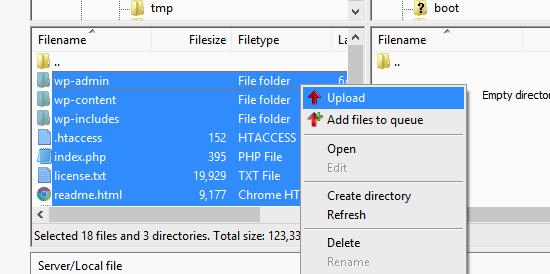
Passo 3: Creare un database MySQL sul sito live
Mentre il client FTP carica i file di WordPress, potete iniziare a importare il database sul server live.
La maggior parte dei fornitori di hosting WordPress offre cPanel per gestire il vostro account, quindi vi mostreremo come creare un database utilizzando cPanel.
Per prima cosa, è necessario accedere alla dashboard di cPanel e fare clic sull’icona “MySQL Database Wizard”, che si trova nella sezione “Database”.

Nella schermata successiva è possibile creare un nuovo database.
È necessario indicare un nome per il database, quindi fare clic su “Crea database”.

cPanel creerà automaticamente un nuovo database.
Successivamente, è necessario inserire un nome utente e una password per il nuovo utente e fare clic su “Crea utente”.
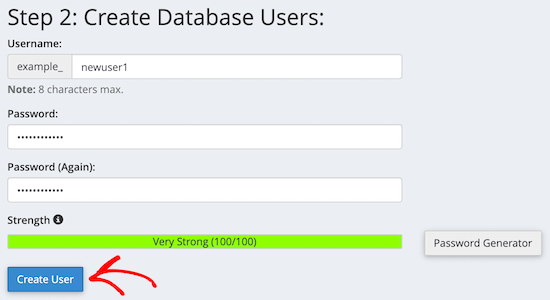
Successivamente, è necessario aggiungere l’utente appena creato al database.
Innanzitutto, selezionare la casella di controllo “Tutti i privilegi”.
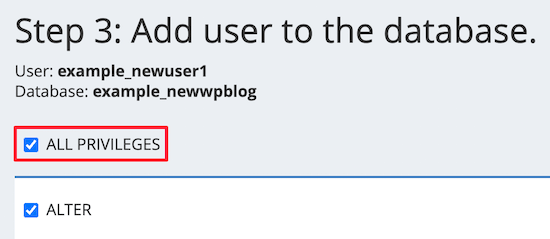
Quindi, scorrere verso il basso e fare clic su “Applica modifiche” per salvare le modifiche.
Avete creato con successo un nuovo database per il vostro sito WordPress live.
Passo 4: Importare il database di WordPress nel sito live
La fase successiva del processo consiste nell’importare il database di WordPress.
Andate nella vostra Bacheca cPanel, scorrete giù fino alla sezione “Database” e fate clic su “phpMyAdmin”.
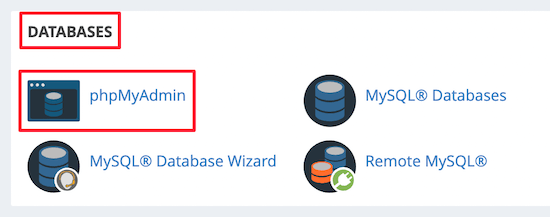
Si accede così a phpMyAdmin, dove si deve fare clic sul database appena creato. phpMyAdmin mostrerà il nuovo database senza tabelle.
Quindi, fare clic sulla scheda “Importa” nel menu superiore. Nella pagina di importazione, fare clic sul pulsante “Scegli file” e selezionare il file del database dal sito locale salvato nel primo passaggio.
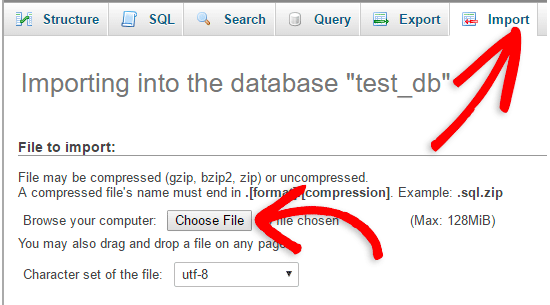
Dopodiché, fare clic sul pulsante “Vai” in fondo alla pagina. Il database verrà importato automaticamente in phpMyadmin.
Passo 5: modificare l’URL del sito
A questo punto, è necessario modificare l’URL del sito nel database in modo che si connetta con il sito WordPress attivo.
In phpMyAdmin, cercate la tabella wp_options nel database che avete appena importato.
Se si è cambiato il prefisso del database, invece di wp_options, potrebbe essere {nuovo_prefisso}_options.
Quindi, fare clic sul pulsante “Sfoglia” accanto a wp_options. Oppure, fate clic sul link nella barra laterale per aprire la pagina con l’elenco dei campi della tabella wp_options.
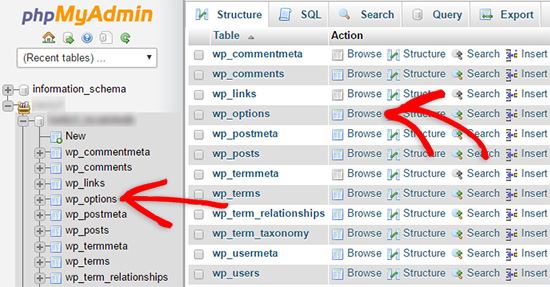
Quindi, nella colonna options_name, occorre cercare l’opzione siteurl.
Quindi, fare clic sull’icona “Modifica”.

Si apre una finestra in cui è possibile modificare il campo.
Nell’input boxed option_value, verrà visualizzato l’URL dell’installazione locale, che sarà qualcosa come http://localhost/test.
In questo campo è necessario inserire l’URL del nuovo sito, ad esempio: https://www.wpbeginner.com.
Quindi, è possibile salvare il campo facendo clic sul pulsante “Vai”.
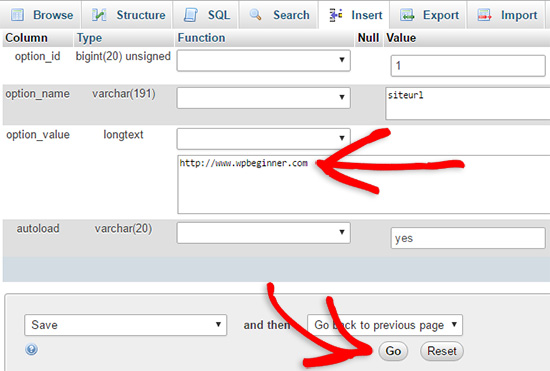
Successivamente, è necessario seguire la stessa procedura descritta sopra per il nome dell’opzione home. Il menu wp_options può essere lungo alcune pagine. Di solito, l’opzione home si trova nella seconda pagina.
Quindi, aggiornare l’URL della home, in modo che sia uguale a quello del sito live.
Passo 6: Configurare il sito live
Ora che avete importato il database e caricato i contenuti, è il momento di configurare WordPress.
A questo punto, il sito dovrebbe mostrare l’errore“Errore nello stabilire una connessione al database“.
Per risolvere il problema, collegarsi al sito web con un client FTP e aprire il file wp-config.php.
Dovrete cercare le seguenti righe di codice:
1 2 3 4 5 6 7 8 9 | // ** MySQL settings - You can get this info from your web host ** ///** The name of the database for WordPress */define( 'DB_NAME', 'database_name_here' );/** MySQL database username */define( 'DB_USER', 'username_here' );/** MySQL database password */define( 'DB_PASSWORD', 'password_here' );/** MySQL hostname */define( 'DB_HOST', 'localhost' ); |
È necessario fornire il nome del database, il nome utente e la password creati in precedenza.
Quindi, salvate il file wp-config.php e caricatelo sul vostro server di hosting WordPress.
Ora, quando si visita il sito web, questo dovrebbe essere attivo.
Dopodiché, è necessario accedere al pannello di amministrazione di WordPress e andare in Impostazioni ” Generale”. Quindi, senza modificare nulla, scorrere fino in fondo e fare clic sul pulsante “Salva modifiche”.
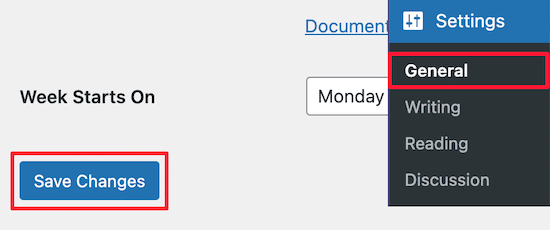
In questo modo ci si assicurerà che l’URL del sito sia corretto ovunque sia necessario.
Una volta fatto, andare su Impostazioni ” Permalinks, quindi scorrere verso il basso e fare clic su “Salva modifiche” per assicurarsi che tutti i link ai post funzionino correttamente.

Passo 7: Correggere le immagini e i link rotti aggiornando i percorsi
Ogni volta che spostate un sito WordPress da un dominio a un altro o da un server locale a un sito live, vi troverete di fronte a collegamenti interrotti e immagini mancanti.
Vi mostriamo due modi per aggiornare gli URL. Potete scegliere quello più adatto a voi.
1. Aggiornare gli URL con il plugin Search & Replace Everything (consigliato)
Il modo più sicuro per correggere questo problema è utilizzare Search & Replace Everything. Si tratta di un potente plugin per WordPress che consente di eseguire facilmente operazioni di aggiornamento di massa sul vostro sito web senza scrivere complesse query al database.
Per prima cosa, è necessario installare e attivare il plugin Search & Replace Everything.
Dopo l’attivazione, andare alla pagina Strumenti ” WP Search & Replace.
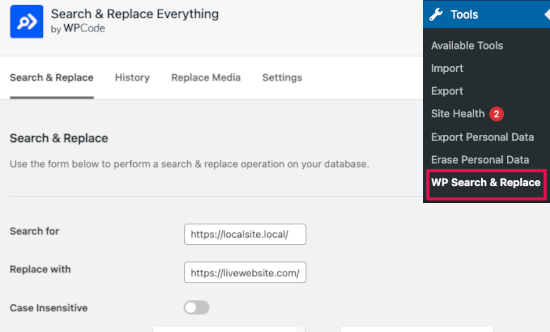
Da qui è necessario inserire l’URL del sito locale nel campo “Cerca” e l’URL del sito live nel campo “Sostituisci con”.
Scorrere un po’ e fare clic su “Seleziona tutto” sotto le tabelle. In questo modo il plugin cercherà il vecchio URL ovunque nel database.

Ora fate clic sul pulsante “Anteprima di ricerca e sostituzione” per continuare.
Il plugin cercherà nel database tutte le istanze del vecchio URL e vedrà l’anteprima dei risultati.
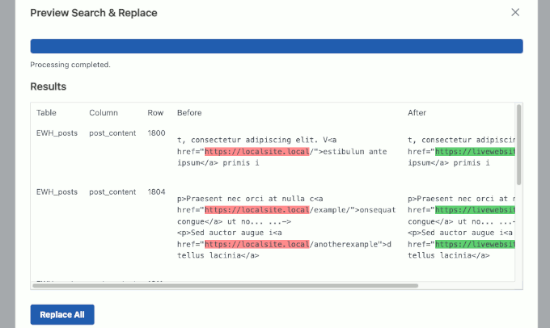
Se tutto sembra a posto, cliccate su “Sostituisci tutto” per salvare le modifiche.
Verrà visualizzata un’attenzione alle modifiche che si stanno apportando. Fare clic su “Sì” per continuare.
Il plugin aggiorna il database e sostituisce gli URL locali con l’URL attuale del sito web.
2. Aggiornare manualmente gli URL (avanzato)
Un altro modo per aggiornare gli URL è utilizzare la seguente query SQL:
1 | UPDATE wp_posts SET post_content = REPLACE(post_content, 'localhost/test/', 'www.yourlivesite.com/'); |
Basta andare su phpMyAdmin, fare clic sul database, quindi cliccare su “SQL” dal menu in alto e aggiungere la query di cui sopra.
Assicurarsi di modificare gli URL del sito locale e del sito live e fare clic sul pulsante “Vai”.
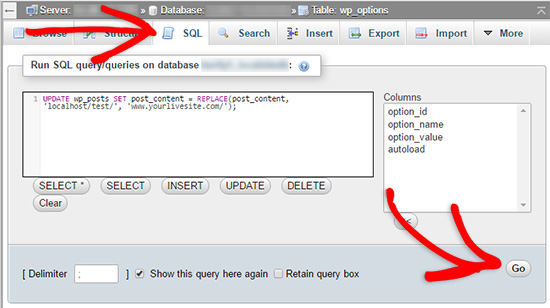
Ecco fatto. Ora avete migrato con successo WordPress dal vostro server locale a un sito live.
Speriamo che il vostro sito web sia attivo e funzionante senza problemi. Se notate degli errori, potete selezionare la nostra guida agli errori comuni di WordPress per aiutarvi nella risoluzione dei problemi.
Speriamo che questo articolo vi abbia aiutato a spostare WordPress da un server locale a un sito live. Potreste anche consultare la nostra guida sullo spostamento di un sito live su un server locale o dare un’occhiata alla lista di controllo definitiva per la migrazione di un sito web per i passaggi pratici della migrazione di WordPress.
Se questo articolo vi è piaciuto, iscrivetevi al nostro canale YouTube per le esercitazioni video su WordPress. Potete trovarci anche su Twitter e Facebook.





divine
Nice article,
Everything was go fine until the signing up on wordpress Admin, i’ve had d domain name for a long time and I can’t remember my wp-admin login details. What can I do to rectify this problem?
Secondly, I tried visiting my site, it opened but the site kept saying the page could not be found, I need help pls
monica
Hi there,
So, My site is runing and seems to work on the Lovalhost/mysite
DB connection is good, settes permalinks to default.
BUT:
all the links fo to the domain (live site) what I’m missing?
O.o
Thanks in advance, great tuto
rdllngr
Everything worked for me. Thanks a lot!
Alem
Helped me go live Thank you.
Thank you.
aqeel
hi plz help i am having this errer when i click import my database plz help
Error
SQL query:
—
— Database: `testword`
—
— ——————————————————–
—
— Table structure for table `wp_commentmeta`
—
CREATE TABLE IF NOT EXISTS `wp_commentmeta` (
`meta_id` BIGINT( 20 ) UNSIGNED NOT NULL ,
`comment_id` BIGINT( 20 ) UNSIGNED NOT NULL DEFAULT ‘0’,
`meta_key` VARCHAR( 255 ) COLLATE utf8mb4_unicode_ci DEFAULT NULL ,
`meta_value` LONGTEXT COLLATE utf8mb4_unicode_ci
) ENGINE = INNODB DEFAULT CHARSET = utf8mb4 COLLATE = utf8mb4_unicode_ci AUTO_INCREMENT =1;
MySQL said: Documentation
#1046 – No database selected
Prasanna
at the top of everything type USE ;
eg if my database name is wordpress then type
use wordpress;
Ngeshlew
Needless to say, you are the website that I always come to check whenever I want to migrate my local WordPress site to a live server.
Thank you guys for the easy steps.
Wafir Manakad
Hey,
Thanks a lot.
I had two queries:
1. On my new website (destination website), I am copying the old files onto an empty public html folder. That is the way right? There is no need to pre-install wordpress on new site?
2. Everything was fine right until the end. I am moving my website from one domain to another.
Finally when I open the new domain, part of the website loads, and partly there are errors. This is the error message:
Warning: include_once(/home/laprimaa/public_html/wp-content/themes/charlottetheme/charlottetheme/theme/plugin/advanced-customizer/lib/ctAdvancedCustomizerMethods.class.php) [function.include-once]: failed to open stream: No such file or directory in /home/laprimaa/public_html/wp-content/themes/charlottetheme/charlottetheme/framework/createit/ctFilesLoader.class.php on line 143
Does this mean I have not uploaded my files correctly?
Any help would be much appreciated.
Best Regards
sandeep kumar singh
how we can give the link of other page except home . i have given the url of home but by using your tutorial i have added post query but my site is not working till now .so please give me information to resolve this.
Shubhayan Ghoshal
Shouldn’t we be replacing the website name -> localhos/{dirname} for ‘guid’ column rather than post_content column?
justin
Okay everything was sailing smooth until I went to import the new database. Upon trying to import it it only puts in wp_commentmeta, wp_comments, wp_links, wp_options and then spits out the error code: ” #1064 – You have an error in your SQL syntax; check the manual that corresponds to your MySQL server version for the right syntax to use near ‘?’ at line 2 “. Now the whole site is down and I don’t have a clue what the heck it is referring too when it says “line 2”. Line 2 of what? And of course the Manual is so friggin helpful man I’ve never seen such helpful stuff (is there a way to type sarcastically?) Please help…
Frosty
Thanks mate. You are a diamond! Ran into a few problems, mainly 123 reg php address was incorrect but got there in the end.
Many many thanks
kathy
Hi, I am trying to import the database but appear to be getting an error. Any ideas anyone? I’m new to wordpress land.
WPBeginner Support
Can you please only paste the error line?
Admin
kathy
I’ve exported my local database and tried to import and it’s returning the below.
Database: `root_wordpress-trunk`
Table structure for table `wp_comments`
#1046 – No database selected
Any help would be greatly appreciated.
Rob
Hello,
I have migrated my site from local to host server. I followed all steps and everything went right but finnaly, I am missing content (posts, pages etc.). Does anybody has any advice?
Yosifov
Hallo, all worked nice so far, but I reached the step 5 where phpmyAdmin is not giving me the option to edit siteurl and home..
amin
thanks for this tutorial ,
I follow this steps and it work correctly i have domain and hosting from godaddy.
Adeel Ashraf
really awsome work (Y)
kanav
do i need to copy all of my data on a live server with preinstalled wordpress ?
like godaddys managed wordpress ?
WPBeginner Support
Yes.
Admin
Claire
Hello,
I have followed all of the steps above, and everything has gone correctly up until the very last part.
I have edited and uploaded the wp-config.php file and now my webpage is just a blank screen and I have not been able to get into edit it in wordpress. I thought I had lost the whole thing…. I changed the urls in php.myadmin back to local/wordpress and can access it again.
What is going wrong please? Any help appreciated!
Thanks, Claire
WPBeginner Support
Undo the changes you made to wp-config.php you have probably missed something when editing it.
Admin
Katy
Ok I’m having the same problem and I’ve uploaded and reuploaded and changed the wp-config.php file. If I deliberately put in something incorrect it shows error establishing database connection. When I put in the correct information I just get a blank page. Blank page for /wp-admin as well.
Jessica CHu
I’m having this same problem… I’m also not able to get access to wordpress back despite changing the wp-config back to the original settings. Have been through all the instructions step by step. I’m using MAMP and Filezilla on EasySpace… Please help!
Michelle Whittaker
Thank you so much! This was exactly the step-by-step resource I needed! I did get a dB error trying to import the gzipped file but I went back and exported the dB as a zip file and imported into new dB and that worked fine.
Chris Jacobsz
Hi,
Thank you for the excellent article. I am a novice and struggled with Duplicator but got my website up and running by following these instructions step by step. Only one thing, my SQL query to update the broken image links did not work. So I had to do it manually.
Thanks very much.
Chris
Mike
Excellent article!!!
One thing to note: Please be sure you know the SQL host server name before you begin! It took me a little while to figure out that “localhost” in the wp-config.php file needed to be changed to the name of my hosting server.
Everything in the article is spot on and saved me hours of moving my Dev site to my hosted provider….
Arjun
Mike, I am using godaddy and how do I find out my SQL host server name? Currently leaving it as ‘localhost’ in wp-config.php file is not helping. Any help appreciated. Been trying but with no luck.
Maggie Walker
Thank you SO SO SO much for this article!!! I am setting up a WP site for a friend for the first time and it was SO helpful to have this article to walk me through the process of going from local to live! I’m a Front End Dev so the help with all of the PHP, SQL, and FTP was incredibly useful.
darrync
hmm, not working for me.
I went through and did this first time and had problems with php.errors.
So I tried a 2nd time and then i finally got the the ‘Error Establishing Database Connection error’
Then progressed until yes i saw my live site.
However when i click on the login to WP admin on the now live site, it takes me to a directory of wp-admin and the whole WP GUI is not shown!
This leads to me think there was an WP install problem…or..?
Note I am a newbie to WP, PHP, CSS, so please explain as if to talk to a 5yo child please :DDDD
thanks
WPBeginner Support
You need to update WordPress urls. If you can use the admin area then go to Settings > General and make sure you have the URL of your live site in both fields.
Admin
obai and hill
I am following the steps and they are very clear and works well every time.
However, this time i followed the steps and when i reached to step 6 where i will have to set up the WP account, the website worked without giving me the error establishing database connection message.
The problem is i can access the new website wp-admin and the pages redirect me to the testing domain. please help
Dave
Thanks for the article. Very helpful!
I have a question. My current live site (fatcow hosting) is running on a very old version of wordpress. My new local site is ready with the latest of everything. I wanted to create a subdomain and test this new site live on different devises and browsers before actually taking it live.
My question is can I have 2 versions of wordpress running on my hosting site? Will ask the host too, but thought I would ask here as well. So the idea is have my current site which is outdated running while I beta test my new site. Once the new site is all good, then I will replace the old with the current. Good idea? Silly naive thinking from a beginner?
Thanks for any help!
-Dave
Bhaumik Dhandhukia
Thank you very much. My site is live and running.
Shaheryar
Thank you!!!!!!!!!!! Life saver article.
Helped me a lot!!!!!!!!! I did everything step by step. Had to change database names accordingly, had to fix broken links manually but hey, its just small stuff to change which I fixed it quickly.
Really appreciate your time and effort to create such a userful site.
Thanks.
cyberwaver
I did everything mentioned here. Mine is am transferring from one host to another host I followed every step here but my website is still showing blank.
check any help will be appreciated.
Wellbein
Hello . I tried all the process and it seems lie I’m the only one here who s a problem. The problem is the white screen. I can’t troubleshoot because the screen is blank. OMG. I am very sure that I followed the instructions when in fact it isn’t my 1st time to migrate a local site to the live site. What does the white screen means? Please help!!
Don_Kihot
I have developed child theme locally, what are the steps to upload to live server?
WPBeginner Support
Simply upload your child theme folder to /wp-content/themes/ directory on your live site. See our guide on how to create WordPress child theme.
Admin
george
thanks for d dis update, my site uploaded well but d pages are not opening fulling, d post and home page open well but the page just open half well. pls help me
olenyash
Best guide i have been through so far — on everything. Thank you a tonne
Dale Powell
This article has saved my life since the day it was published. Can’t thank you enough
Osama
Great Work !
This Transfer Method Works Good Work
Thank You
Ben
Excellent article. I’ve just followed it step by step for my new business website I’ve been developing on WAMP.
Keep up the great work!
Ben.
Rudra
Really great thanks man
Juan C
THANKS MAN!!!!!
Matthew Eaton
At step 5, I cannot alter the site url or home. It won’t give me the option of editing.
What went wrong?
Chris
There is an icon like “pencil”, you can click that
Adam
When I import all files and database I have error 500 on subpages… Why??
anthony
when I import my database not all of the tables are there. I’m wondering what I’m doing wrong….
Jay Doshi
Firstly You have to select your database(Click on your create database name) and then import your .sql file.
Kailashkumar
Sir i want to upload WordPress site form local host to live server.
Robin
One tip maybe I can help someone with this.
My database from my localserver was far too big to import due to the import limit.
I have used the 7ZIP program to zip my exported database to a gzip file.
This has solved the problem for me.
Thanks for the article! At the moment my website is uploading…
Thijs
Thank you very much for the tutorial. I regret to say that after step 5 everything went blank.
The site is gone and I am not able to recover the information.
I can not believe that creating a simple site can be so difficult.
Robin
Thanks for the info.
Tomorrow I am going to replace my wordpress website. I am reading some people are having issues with the thaccess file. Do I have to change the site adress in this file or not?
Thanks!
Claudio
This was certainly a very helpful tutorial, but why go through such a lengthy process when you can just export and import everything? There might be a couple of things missing like the media library but that’s really easy to download and upload.
I’ve been creating child themes for a while and this what i do for my clients:
– create the whole child theme abs site offline
-once finished simply select expert everything from the settings
-install WordPress on the line host
-select import and point it to the xml file produced before
-that’s it! All your post and pages should be there now
– simply install the cold theme you’ve created and tweak what ever looks “funny”.
I hope this helps.
Aurang Zeb Khan
I am trying since 2 days, “i spend almost full day” but could not succeed. I wanted to try a simple website with only one post so that i could get to know how the whole process will go when i complete my site in the wordpress.
I have done all the steps successfully but when i try to import database to the hosting website an error occurs and i dont know how to solve this. i am using SmartFTP. can anybody help?
Alex Evans
Hi, I understand this process, but can anyone send me a link or tell me the process for taking a locally hosted WP site and uploading it to go live, where there already exists a site on the domain?
For example if I’m creating a new site for someone and now I need the locally hosted site to appear for said domain instead of the hold one.
I’m confused on how DNS works
Raja Asad
Hi ,
please anyone help me out
actually i did all these steps that mentioned above but still couldn’t upload my site form local host to live server
what else i do ?
Asad
Hi ,
i did these all steps but yet i am able to transfer my site from local to c panel
please suggest one thing more is there already word press install on c panel or we have to install it there ?
PAUL
Hi
Thanks for an excellent article – clear, concise, well-illustrated and easy to follow. I’ve been uisng Duplicator for ages, but it just decided – this time – that it wasn’t going to play fair!
Everything worked perfectly until Step 7. The SQL query fixed some, but not all, path changes. I then resorted to the Velvet Blues plugin, which fixed all but one path. I’m still struggling to find a solution for the following:
I have a plugin which utilises its own (two) stylesheets. While Velvet Blues has changed the path to one stylesheet, the other doesn’t want to change. Any ideas how I can effect this manually?
Thanks and regards
Paul (“Webbo”)